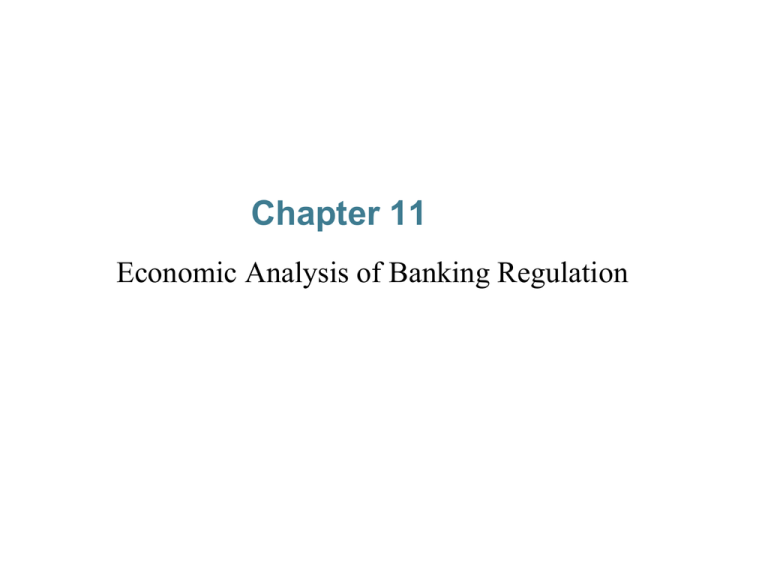
Chapter 11
Economic Analysis of Banking Regulation
Bank Failure
• Any indication of insolvency can cause a run
on banks which can push a healthy bank into
insolvency
– creating losses for its owners and depositors
• Depositors cannot tell the good from the bad.
– problem of asymmetric information.
• “Contagion effect”
An Example of a Bank Run
• Assume depositors lose confidence in an otherwise healthy
bank causing a run of the bank
• The bank first uses liquid reserves and sells securities to
meet depositor demands to withdraw funds
• The bank is next forced to sell loans at the fire-sale price of
$0.50 per $1, the bank pays off half of remaining deposits
• The bank cannot pay off the remaining deposits and has
negative net worth, so the remaining depositors and bank
owners both lose.
Run on a Bank - Example
Liquidate at
100%
Liquidate at
50%
Total = $40 + $40 = $80
Cyclical downturns are associated with
bank panics (bank runs)
• The period prior to the Federal Reserve
from 1871-1913
– Eleven recessions
– Bank panics during 7 recessions
– No panics without recessions.
The Government Safety Net
• Lender of Last Resort (Federal Reserve 1913)
• Deposit Insurance (FDIC 1934)
Federal Reserve: Lender of Last Resort Safety
Net
• Intent - Lend to solvent but illiquid
banks
• Does this create a moral hazard?
– Does the “lender of last” resort encourage
banks to take on too much risk?
FDIC Deposit Insurance Safety Net:
• Intent - stop run on bank
• Does this create a moral hazard?
- Depositors lose incentive to monitor risk taken
by the bank’s managers
- Do banks have incentive to take on more risk?
• Before deposit insurance, ratio of assets to bank
capital was 4 to 1 ( 25% capital ratio)
• After deposit insurance, ratio of assets to bank
capital was 13 to 1 (7.7% capital ratio).
Government Safety Net: “Too Big to
Fail”
• Government provides guarantees of repayment
to large uninsured creditors of the largest
financial institutions even when they are not
entitled to this guarantee
• Can increases moral hazard incentives for big
banks
•
•
•
•
•
FDIC
Created in 1934
Eliminate run on banks and prevent
bank failure
Deposits now insured up to $250,000.
1930 – 1933, 2000 failures per year.
1934 - 1981 fewer than 15 failures per
year.
What does the FDIC do if bank fails?
• Payoff method.
• Purchase and assumption method.
http://www.fdic.gov/news/news/pre
ss/2012/pr12120.html
How to reduce Moral Hazard in Banking
1.
Place Restrictions on Asset Holdings
– Reduces moral hazard of too much risk taking.
For example, Glass - Steagall Act, bank’s can’t
hold common stock.
– Promote diversification - Limits on loans to
particular borrower or industry.
2. Minimum Bank Capital Requirements
– Banks have more to lose when have higher
capital.
– Also, higher capital means more collateral for
FDIC to grab.
How to Structure Capital Requirement
• There are two forms:
– The first type is based on the leverage
ratio, the amount of capital divided by the
bank’s total assets. To be classified as
well capitalized, a bank’s leverage ratio
must exceed 5%; a lower leverage ratio,
especially one below 3%, triggers
increased regulatory restrictions on the
bank
– The second type is risk-based capital
requirements
Basel – I Risk Based Capital Requirement
Asset
Cash and equivalents (reserves)
Government securities
Interbank loans (Federal Funds)
Mortgage loans
Ordinary loans (Comm’l and Industrial)
Risk
Weight
0
0
0.2
0.5
1.0
Capital Requirements for Melvin’s
Bank
First National Bank
Capital Requirements for Melvin’s
Bank
How to reduce Moral hazard (Con’t)
3. Bank Supervision: Chartering and Examination
A. Chartering reduces adverse selection problem of risk
takers or crooks owning banks
B. Examination reduces moral hazard by preventing
risky activities
–
–
–
–
–
Capital adequacy
Asset quality
Management
Earnings
Liquidity
Sensitivity to market risk: Implementation of stress
testing and Value-at risk (VAR)
Bank Failures in the United States, 1934–2010
1982-1989: U.S. Bank Crisis
(General Economic Context)
• Worried about inflation in late 1970s, Fed sharply tightened
the money supply starting in late 1979.
• Result - in high interest rates (i) and sharp deep recession
in 1981-1982.
• As i increased, increased costs of funds for Savings and
Loans (S&Ls), not matched by higher earnings on principal
assets (residential mortgages) whose rates were fixed.
• By some estimates, over half of S&Ls in U.S. were
insolvent by end of 1982.
13-19
Why a Banking Crisis in 1980s?
Early Stage: Financial Innovation and Increased
Competition
1. Banks and S&L’s loss of “sources of funds”
advantage to competition due to financial innovation
- Money Market Mutual Funds (intro. 1971)
- π =>i => loss of deposits and increased cost of
funds
2. Loss of “uses of funds” to competition due to
financial innovation in direct finance
- commercial paper and junk bonds
3. Result - loss of revenues and loss of cost advantages
=> reduced profits
Why a Banking Crisis in 1980s? - Early Stage
4. Also, lack of diversification
• No branch banking caused lack of geographic
diversification
• Lack of industry diversification - Texas banks
concentrated in energy loans
Result: Risky loans and bank failures.
Commercial banks got into real estate and corporate
take over loans.
S & L’s got into loans they knew nothing about such
as commercial and industrial.
Why a Banking Crisis in 1980s?
Later Stages: Regulatory Forbearance (Regulatory Failure)
•
Insolvent banks should have been closed, but regulators
allowed insolvent S&Ls to operate with lowered capital
requirements (“zombie banks”) :
–
–
–
Insufficient funds to pay depositors.
Sweep problems under rug.
Regulator ( FHLBB) cozy with S&Ls
•
Huge increase in moral hazard for zombie “living dead”
S&Ls. They have nothing to lose, their incentive is to
“gamble for resurrection”
•
The zombies became vampires. Hurt healthy S&Ls by
attracting funds away by offering above market rates.
•
Outcome: Huge losses
Political Economy of S&L Crisis
Explanation: Principal-Agent Problem
• Politicians influenced by S&L lobbyists rather
than public
• Deny funds to close S&Ls
• Passed legislation to relax restrictions on S&Ls.
S&Ls allowed to expand into commercial real
estate, credit cards, junk bonds and even
common stock. S&Ls had no experience in these
areas
• Regulators influenced by politicians and desire to
avoid blame
A. Loosened capital requirements
B. Regulatory forbearance. Insolvent S&Ls and
banks allowed to remain in operation.
DIDMCA(1980)
• Depository Institutions Deregulation and
Monetary Control Act
– S&Ls - allowed to hold up to 40% commercial real estate
– S&Ls - allowed to hold up to 30% consumer loans and 10%
junk bonds and common stock.
• FDIC deposit insurance increased from $ 40,000 to
$100,000
• Phased out Regulation Q restrictions on interest rates.
This allowed banks to issue large denomination insured
CDs
11-24
Turning Point: Financial Institutions Reform,
Recovery and Enforcement Act (FIRREA) of 1989
• Resolution Trust Corporation (RTC) created
and given funds to close insolvent S&Ls
–
–
cost of $150 billion, 3% of GDP
750 (25%) of S&Ls closed.
• Capital requirement for S&Ls increased from
3% to 8%
• Re-regulation: Re-impose pre-1980 asset
restrictions on S&Ls
Federal Deposit Insurance Corporation
Improvement Act (FDICIA) of 1991
Prompt Corrective Action
An undercapitalized bank is more likely to fail
and more likely to engage in risky activities.
The FDIC Improvement Act of 1991 requires the
FDIC to act quickly to avoid losses to the FDIC.
“Undercapitalized banks” must submit a capital
restoration plan, restrict asset growth, and seek
regulatory approval to open new branches or
develop new lines of business.
http://www.fdic.gov/bank/individual/failed/
Cost of Banking Crises in Other Countries (a)
Cost of Banking Crises in Other Countries (b)
© 2004 Pearson Addison-Wesley. All rights reserved
11-28
Déjà Vu All Over Again!
Banking crises are just history repeating itself.
Financial liberalization leads to moral hazard (and
bad loans!).
Government stands ready to bailout the system. That
implicit guarantee is enough to exacerbate the moral
hazard problem.

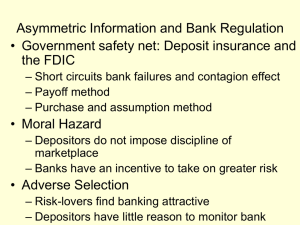
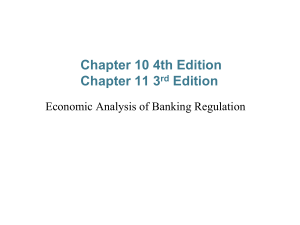



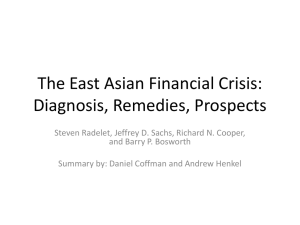
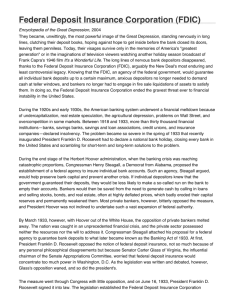
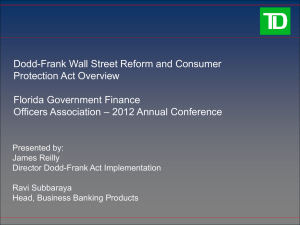


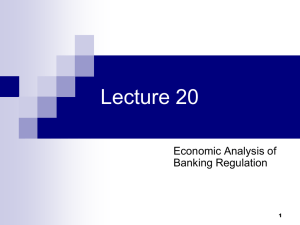
![Group 3: [ppt]](http://s2.studylib.net/store/data/005555633_1-b7fbb3f17747662fcc3e6828f2194ad8-300x300.png)